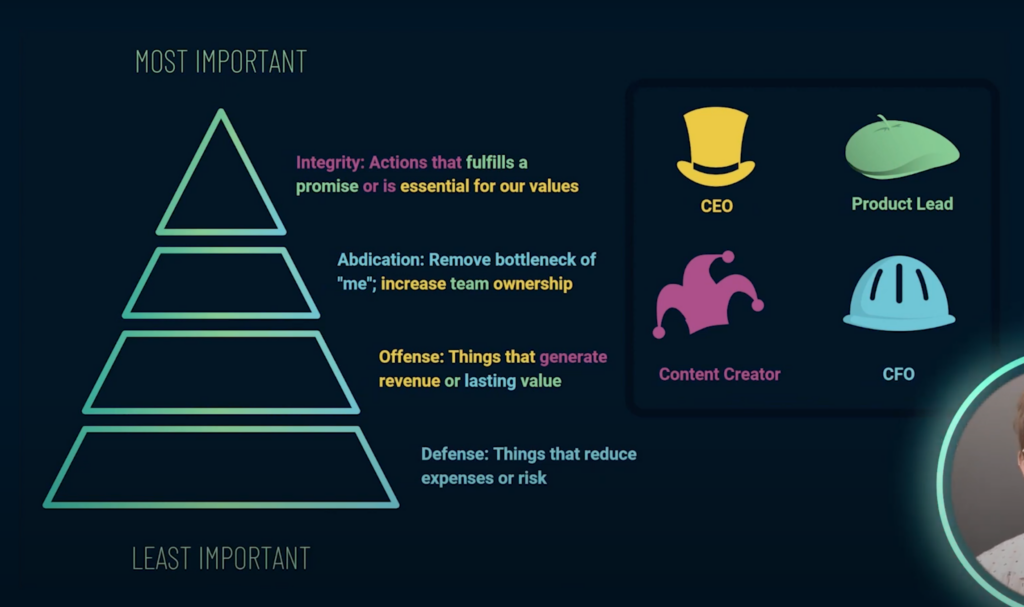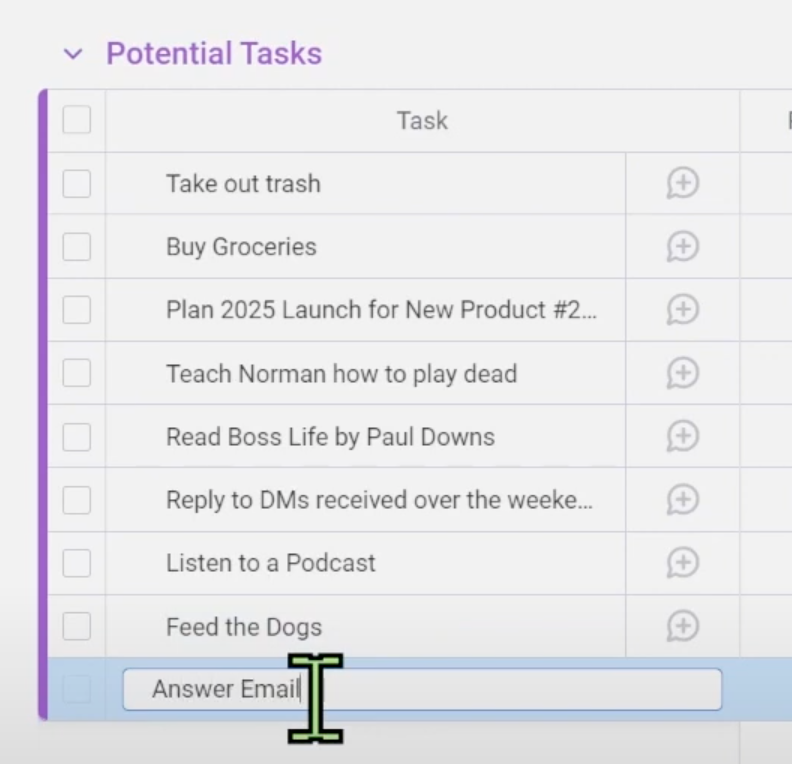If you work on a small team, your job most likely forces you to figure out how to balance multiple roles. But without any guidance on how to do so, you’re stuck feeling overwhelmed, stressed, and burnt out.
In this video, we’re showing you the 4 steps you need to learn to finally be able to balance multiple roles at work, along with action-oriented exercises to help you get there!

This post may include affiliate links, meaning we might earn a commission. For more details, check out our terms.
Not a video person? No worries! We’ll cover all the main points in this article.
Introduction
Working with a team made up of less than 100 people? If the answer is yes, you’re most likely used to wearing numerous hats on any given day. You might be the Marketing Manager in the morning and Public Relations Officer in the afternoon.
When we’re trying to balance multiple roles at work, deciding which tasks are most important to do first can become challenging. This can quickly become confusing and overwhelming — and then we end up procrastaplanning (the act of procrastinating planning ahead).
Now we’re paralyzed by all the possibilities and unable to take action.
By the end of this article, we’ll be able to clean up all those hats we have lying around and divide them into bite-sized containers to finally be able to balance multiple roles. We just have to follow these four steps!
Step 1: Identify Your Constraints
Constraints = measurable units (i.e., hours, days, times, etc.)
We first want to define the box we are working in. If we’re talking about the work day, for most people, the constraint they face is working 8 hours per day. If we know we only have 8 hours per day to get work done, let’s set that limit from the onset, so we know what we’re working with.
Once we’ve defined our constraints, we can move on to step 2.
To watch this explanation in video format, watch the video at the top of this article at timestamp 01:51.
Step 2: Prioritization Hierarchy
Now it’s time to figure out what’s most and least important to us.
ProcessDriven’s suggestion: build a hierarchy of priorities.
Let’s use a real-life example using Layla at ProcessDriven! Layla currently wears the following hats:
- CEO
- CFO
- Product Lead
- Content Creator
Her hierarchy of prioritization looks like this:

She has four layers that track what’s most and least important to her in the current quarter.
At the very top of the hierarchy, Layla has things related to Integrity — anything that fulfills a promise we made OR is essential to achieving our mission, vision, and values. She deems this necessary to go to the top of her prioritization hierarchy.
Runner-up on her list of priorities is things related to Abdication — anything that prevents Layla from becoming a bottleneck to the rest of the team. This can look like hiring people with specific skill sets to take things off Layla’s plate or creating SOPs around tasks she’d like to delegate.
The third level of the hierarchy is Offense — anything related to the growth of the business. The last level of Layla’s hierarchy is Defense — anything related to operations and sustainability.
Now when Layla looks at her to-do list, she knows how to prioritize her work using this hierarchy to balance her multiple roles.
Remember that our prioritization hierarchy will most likely change as the business needs change.
If you’d like to start taking action today, we suggest grabbing a piece of paper — or beginning a new Doc — and breaking up your work into 3 – 5 categories that you can easily prioritize using the hierarchy of prioritization.
To watch this entire explanation in video format, watch the video at the top of this article at timestamp 03:25. If you want to see another real-life example using a more traditional multi-role scenario, watch the video at timestamp 07:55.
If you're looking to systemize your operations, define your processes with action-oriented exercises, and equip them with SOPs, automations, delegation, and more -- check out our FREE strategy training, The Blueprint, to learn more.
Step 3: Make a Shortlist
Now it’s time to look back at the work we know we need to do and start putting it in order. We’re trying to establish a shortlist of the top 5 or fewer tasks we know we need to work on in order of importance.
Let’s go through an example using the work management tool Monday.com*. Let’s say this is our task list:

If Layla’s number one priority is Integrity, then “Replying to DMs received over the weekend” should probably be at the very top. “Feed the Dogs” and “Answer Emails” should also go at the top.
Out of all these tasks, we’ve identified the top 3 tasks that should go on our shortlist.
Now we can identify which tasks should be in Layla’s second level, Abdication. If “Read Boss Life by Paul Downs” will help prevent Layla from becoming a bottleneck for Team ProcessDriven, it should be included in this second hierarchy level. “Listen to a Podcast” and “Plan 2025 Launch for New Product #23” can also be included in this second level.
This shortlist now contains 6 tasks — which is more than should be on our shortlist. It’s time to start having things compete.
This is when we ask ourselves, “If I had to remove one task from this list, which is the least impactful?”
Let’s remove “Plan 2025 Launch for New Product #23” from the shortlist since it’s most likely a pie-in-the-sky idea, and we can kick that one back for now.
Once we’ve identified the 5 tasks on our shortlist, we’ll lock them in. We are not making any changes to this shortlist until they’re completed or the time has come to create a new shortlist — whichever comes first.
If you’re struggling to create your shortlist and want to dig deeper into this step in the process, check out this framework for prioritization.
Once our shortlist is set, we can move on to step 4.
To watch this explanation in video format, watch the video at the top of this article at timestamp 10:47.
Step 4: Do the Work
Hard truth time: we will eventually have to do the work we’ve just organized. (
This step is about action and figuring out the most efficient way to get things done. Keep in mind what works for one person might not work for another. Finding that personal flow is one step in a long journey. If you’d like tips that can help you get there, check out this article.
Generally speaking, grouping priorities by role per day — for example, Tuesday is CEO day and Thursday is Product Lead day — isn’t the best route for most people.
Rather than thinking by role, try thinking of the type of work. For example, types of work might be:
- High vs. Low Creativity Tasks
- High vs. Low Energy Tasks
- High vs. Low Willpower Tasks
Try to give yourself a nice variety pack of these different types of tasks on any given workday. One suggestion would be to mix high and low-energy tasks in one day. For example, if we have a bunch of meetings one day (high energy and low creativity), we’ll try to pair that with very high creativity and low energy tasks.
Our goal is to have a balanced workday!
Once we put this into practice, we’ll find our personal flow that works for our mind, personality, and team environment.
To watch this entire explanation in video format, watch the video at the top of this article at timestamp 16:00. To hear another suggestion on how to balance multiple roles on any given day, watch the video at timestamp 18:43.
repeat the process
This entire process is meant to be repeated. As a starting guideline steps 1 and 2 can be repeated monthly or quarterly as business needs change. Steps 3 and 4 should happen daily — this means every day, we should plan our top 5 things for the following day. Repeat this at the end of every day!
However, if we find ourselves overwhelmed by too many options and end up spending 50 minutes on this process instead of 5, let’s reduce that cadence to once a week.
If you’re an employee, we suggest you implement this process and bring it to your direct manager. You can say, “This is what I deem my top 5 priorities. Would you agree?”
This ensures you’re working towards alignment on your career goals and the responsibilities you carry.
Until next time, enjoy the process!
If you're looking to systemize your operations, define your processes with action-oriented exercises, and equip them with SOPs, automations, delegation, and more -- check out our FREE strategy training, The Blueprint, to learn more.
*Some links might include affiliate links.
